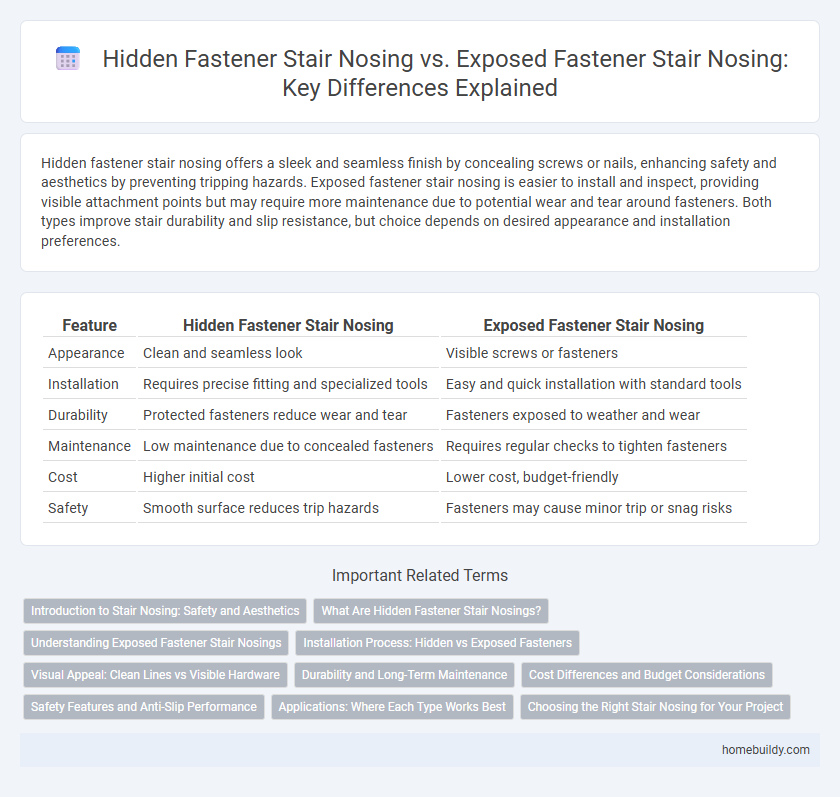Hidden fastener stair nosing offers a sleek and seamless finish by concealing screws or nails, enhancing safety and aesthetics by preventing tripping hazards. Exposed fastener stair nosing is easier to install and inspect, providing visible attachment points but may require more maintenance due to potential wear and tear around fasteners. Both types improve stair durability and slip resistance, but choice depends on desired appearance and installation preferences.
Table of Comparison
| Feature | Hidden Fastener Stair Nosing | Exposed Fastener Stair Nosing |
|---|---|---|
| Appearance | Clean and seamless look | Visible screws or fasteners |
| Installation | Requires precise fitting and specialized tools | Easy and quick installation with standard tools |
| Durability | Protected fasteners reduce wear and tear | Fasteners exposed to weather and wear |
| Maintenance | Low maintenance due to concealed fasteners | Requires regular checks to tighten fasteners |
| Cost | Higher initial cost | Lower cost, budget-friendly |
| Safety | Smooth surface reduces trip hazards | Fasteners may cause minor trip or snag risks |
Introduction to Stair Nosing: Safety and Aesthetics
Stair nosing enhances safety by providing slip resistance and edge visibility, significantly reducing fall risks on staircases. Hidden fastener stair nosing offers a sleek, seamless appearance by concealing installation hardware, making it ideal for modern aesthetic demands. Exposed fastener stair nosing, while more visible, allows for easier maintenance and stronger attachment, balancing durability with functional safety.
What Are Hidden Fastener Stair Nosings?
Hidden fastener stair nosings are designed with concealed attachment systems that provide a clean, seamless appearance by hiding screws or nails beneath the nosing surface. These stair nosings enhance safety by reducing trip hazards and maintain aesthetic appeal in commercial and residential staircases. Common materials include aluminum, PVC, and rubber, all engineered for durability and slip resistance while securing firmly without visible fasteners.
Understanding Exposed Fastener Stair Nosings
Exposed fastener stair nosings feature visible screws or nails that secure the nosing to the stair tread, offering straightforward installation and ease of replacement. They provide a cost-effective solution with reliable durability, commonly used in commercial and industrial settings where maintenance speed is prioritized. The visible fasteners can, however, pose minor safety risks due to potential snagging and may require regular inspection to ensure fastener integrity.
Installation Process: Hidden vs Exposed Fasteners
Hidden fastener stair nosing requires precise measurements and specialized tools for installation, ensuring fasteners are concealed beneath the surface for a clean, seamless appearance. Exposed fastener stair nosing installation is generally simpler and faster, involving screws or nails visible on the nosing surface, which allows for easier maintenance and replacement. The hidden fastener method enhances aesthetic appeal and reduces tripping hazards, while exposed fastener systems prioritize straightforward installation and cost-effectiveness.
Visual Appeal: Clean Lines vs Visible Hardware
Hidden fastener stair nosing offers a sleek, modern finish with clean lines that enhance the overall aesthetic of stairs by concealing screws and nails. Exposed fastener stair nosing displays visible hardware, which can disrupt the visual flow and appear less refined but may provide easier installation and maintenance access. Choosing hidden fasteners ensures a polished, seamless look ideal for contemporary designs, while exposed fasteners suit more industrial or utilitarian settings.
Durability and Long-Term Maintenance
Hidden fastener stair nosing offers superior durability by protecting fastening elements from wear, corrosion, and environmental exposure, resulting in reduced maintenance over time. Exposed fastener stair nosings are more susceptible to damage and loosening, increasing the frequency of repairs and replacements. Choosing hidden fastener options extends lifespan and minimizes long-term maintenance costs in commercial and high-traffic applications.
Cost Differences and Budget Considerations
Hidden fastener stair nosing generally incurs higher installation costs due to the need for specialized tools and labor expertise, increasing overall project expenses. Exposed fastener stair nosing offers a more budget-friendly option with straightforward installation, reducing labor time and costs. When balancing durability and aesthetic preferences, project budgets must account for the higher initial investment of hidden fasteners versus the cost-effectiveness of exposed fastener systems.
Safety Features and Anti-Slip Performance
Hidden fastener stair nosing enhances safety by eliminating protruding screws or nails, reducing trip hazards and creating a smoother surface for foot contact. Exposed fastener stair nosing, while easier to install, can pose risks due to visible screws that may catch footwear or cause injury. Both types incorporate anti-slip materials or textures, but hidden fastener options often provide a more consistent and uninterrupted grip surface, improving overall slip resistance on stair edges.
Applications: Where Each Type Works Best
Hidden fastener stair nosing is ideal for commercial and high-traffic areas where aesthetics and safety are priorities, providing a seamless look and reducing trip hazards by concealing screws or nails. Exposed fastener stair nosing suits industrial or maintenance-heavy environments where ease of installation and inspection outweigh appearance, allowing quick replacement and adjustments. Choosing the right type depends on balancing visual appeal, durability, and accessibility requirements specific to residential, commercial, or industrial staircases.
Choosing the Right Stair Nosing for Your Project
Hidden fastener stair nosing offers a sleek, seamless look by concealing screws or nails, enhancing aesthetics and reducing trip hazards, making it ideal for commercial spaces requiring a clean finish. Exposed fastener stair nosing provides easier installation and maintenance, often preferred for industrial or high-traffic areas where durability and quick replacement are priorities. Selecting the right stair nosing depends on project requirements such as safety standards, visual appeal, installation complexity, and long-term maintenance needs.
Hidden fastener stair nosing vs Exposed fastener stair nosing Infographic

 homebuildy.com
homebuildy.com